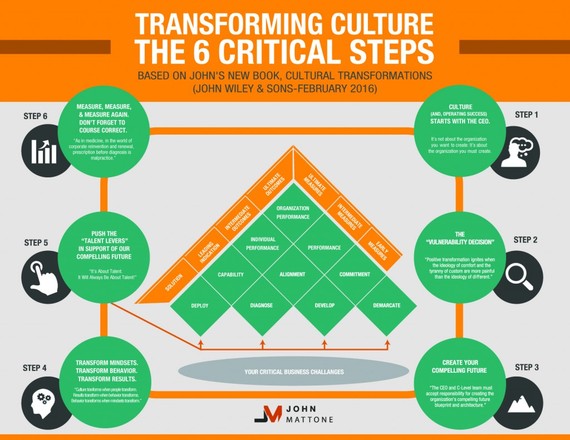
Your company culture is the unique collection of values that defines for your organization, what is and is not tolerated, accepted, and lauded. If corporate transformation sounds difficult, that's because it is. According to research done by The Boston Consulting Group, PwC, and my own research, 75% of business transformations flat-out fail. But difficult doesn't mean impossible. We have discovered that the biggest impediment to achieving a successful corporate transformation effort: Culture. And, your culture starts with the leadership of your CEO and c-level team.
But, here's the good news: We have discovered in our research and interviews we did with 14 top global CEO's, that organizations are able to change mindsets, decisions, and behaviors that define culture. We found that successful business transformation starts with great leadership from the CEO and c-level team. It is a non-negotiable requirement that the CEO and c-level team must be great leaders. In part, this involves possessing the duality mindsets of thinking different and thinking big, counterbalanced with humility. Here's the bad news: CEO's who possess this duality mindset, are in short supply. Culture transformation must be led, embraced and "lived" at the top. Ultimately, this is the prerequisite for culture transformation support to take hold throughout the organization so individuals and teams can make the required changes.
Why Companies Resist Change
Even when there are clear reasons to transform, organizations can be resistant. Whether your company is laid-back or strictly by-the-book, introducing cultural change - is a long, challenging process. Most transformation efforts that succeed take 3 years, minimum. Corporate culture is a unifying dynamic, and even if people don't love it, they're familiar with it. Change can be threatening.
Besides unfamiliarity, sunk costs are another reason many organizations resist change. This is particularly true if the organization has invested significant time, effort, or money in pursuit of certain business goals. Cutting losses and trying a different approach will almost certainly meet with resistance. But the costs of change don't decrease if the organization refuses to act altogether.
Knowing When Culture Change Is Necessary
What results do you want your company to achieve? If everyone continues doing what they're doing now, are such results possible? If not, cultural change is necessary. Furthermore, organizational cultures can grow stale over time. Success itself can generate complacency, as can leaders who overestimate their own importance. When this happens, competitors have a great opportunity to get ahead. Bringing in a culture change consultant adds legitimacy and seriousness to company leadership's words about wanting change.
Another sign company culture is due for change is when employees act differently when the CEO and senior leaders are around than when they are not. Strong, effective company culture leads employees to act consistently whether or not anyone is watching. When positive behaviors are motivated from within, and reinforced by the surrounding culture, the presence of the CEO nearby isn't necessary for great performance.
Positive Changes Successful Culture Change Can Bring
A strong company culture has countless positive effects, including an often significant labor cost advantage. Think about the lists of "Best Places to Work" and the 14 companies I cite in my new book: Cultural Transformations: Lessons of Leadership and Corporate Reinvention. Companies like Zappos, Google, Apple, Wegmans, Graybar, Genpact, and Virtusa. These are typically places with a strong, identifiable corporate culture, and valued employees are more likely to refer people they know who fit the culture when employment positions open up.
Another tremendously positive change that can result from cultural change is better loyalty among both employees and customers. Think about the brands with the most loyal fans, like Apple. Any corporate culture looking for this level of customer loyalty simply cannot tolerate ineffective behaviors among leaders or front-line workers.
Requirements for Successful Corporate Culture Change
To know which direction to go, the CEO and c-level team has to define what they want the desired culture to be like and reasons why it's necessary to get there. The most important question to ask and answer is, "What is the business imperative for culture transformation"? My culture transformation consulting team and I can't be of much help if company leadership isn't specific about the business outcomes it wants. Are you trying to become more innovative? customer-oriented? institute a stronger execution culture? This is where successful transformation efforts begin.
Measure, measure and measure again. Yes, culture can be measured. The problem is only about 15% of global companies measure the health and vibrancy of their culture. By comparison, 75% of global companies measure engagement levels of their employees. Yet, it is culture that drives engagement. Therein lies the problem. Most companies are not calibrating and addressing the "leading indicators" that drive engagement and ultimate operating success.
It's also necessary to define for every employee why it's in their personal interest to embrace cultural change. Everyone needs to be able to envision the benefits of cultural change so they're motivated to make the necessary changes in their day-to-day work.
But cultural change doesn't mean throwing everything out. There may be ways the current culture works well and can help achieve organizational goals. In these cases, recognizing those cultural touch points can reduce everyone's change-related anxiety. But company leadership must support the desired culture through rewards systems, performance management, and training for change to really gain traction.
The 6 Critical Steps Required to Transform Culture
- Culture starts with the CEO. Are you a CEO who 'Thinks Different" and "Thinks Big"?
Corporate Culture Exists Whether You Define It or Not
Whether you articulate it or not, your organization has its own culture. When corporate culture is ignored, it might evolve in a way that's good, but then again, it might calcify into a culture that drives away your best people and stifles improvement efforts. Know the goals you want the organization to achieve and learn what changes are necessary to achieve them. Change is hard, but nothing worthwhile is easy.